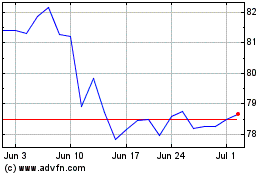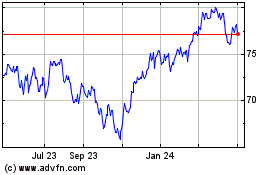Lingering economic concerns and a still high American
unemployment rate are compelling investors to look outside the U.S.
markets, which currently offer unique opportunities with higher
returns and relatively low risks.
Presently, the emerging markets are in the initial phase of
growth and show the potential to outpace developed markets moving
forward. Accordingly, the development of ETFs in these
up-and-coming areas promises long-term rewards for investors
betting their money on this interesting region.
In this article, we look at the seven largest equity ETFs
outside the U.S. market, which are most popular and the largest in
the space. There are literally more than 100 funds in this segment
but these stand out as popular vehicles for those looking to
achieve a broad exposure to these markets. (Read: Three Overlooked
Emerging Market ETFs)
Vanguard MSCI Emerging Markets ETF
(VWO)
In order to play in the broader emerging market, investors can
pick Vanguard’s VWO initiated in March 2005. With total assets of
$53.9 billion, the fund tracks the price and performance of the
MSCI Emerging Markets Index.
The fund is diversified and holds 900 securities of emerging
markets such as Brazil, Russia, China, Korea, and Taiwan. Giant and
large companies hold more than 75% of assets with 13.41%
concentrated in top 10 holdings. VWO is heavily exposed to
financial services followed by technology, basic materials and
energy. (Read: Top Three High Yield Financial ETFs)
The fund is appropriate for long-term holdings and has a higher
growth potential than the developed countries. The fund generated
outstanding 18.11% returns over the past one-year period (as of
March 2012). The ETF charges a low fee of 20 bps compared with the
category average of 0.65% and yields an annual dividend of
2.12%.
iShares MSCI Emerging Markets ETF
(EEM)
For another ETF tracking the same market and index, investors
should focus on iShares entrant in the space. Initiated in April
2003, EEM is the full replication strategy, holding 838 stocks in
MSCI Emerging Markets Index. With total assets of $38.3 billion,
the fund puts 16.3% of its assets in top 10 holdings.
The large part of the assets is weighted towards China, South
Korea, Brazil and Taiwan, with a combined share of more than 55%.
India, Mexico, Malaysia and Indonesia represent a smaller market
share. From the sector’s perspective, the fund is heavy on
financials, information technology and energy while light on
utilities and healthcare.
Top five holdings include Samsung Electronics, China
Mobile (CHL), Gazprom, Taiwan Semiconductor
Manufacturing (TSM) and America Movil
(AMX). (Read: What Bubble? China ETFs Soaring To Start 2012)
The fund is the high-cost choice in the emerging market space as
it charges a slightly higher fee of 67 bps a year compared to the
category average of 64 bps. The product had generated a lackluster
negative 9.40% annual return last year (as of March 2012). However,
the fund is highly traded and liquid with the small bid/ask ratio
and good tracking error. The product provided a dividend yield of
1.91% per annum.
iShares MSCI EAFE
(EFA)
For the broad exposure in the developed market space, investors
may find EFA issued by iShares as an interesting option for
playing. The fund seeks to match the price and performance of the
MSCI EAFE Index, before fees and expenses. The MSCI EAFE Index is a
free-float capitalization-weighted index that aims to capture at
least 85% of the total market capitalization, holding 923 stocks in
the index.
Stocks in the index consist of publicly traded companies in the
European, Australasian and Far Eastern markets. The fund uses a
passive index strategy and utilizes a full replication technique,
holding 933 stocks of companies in its basket. The fund focuses
largely on the United Kingdom and Japan with financial as the top
sector. (Read: Japan ETFs: One Year After The Fukushima
Disaster)
The product is the least concentrated from an individual
security perspective as it puts around 13% of the assets in top 10
companies, including Nestle, HSBC Holdings (HBC),
and Vodafone Group (VOD). Initiated in August 2001
and with total assets of $36.6 billion, the fund is the low cost
choice in the developed market space with an expense ratio of
0.34%.
Like many other developed market ETFs, EFA underperformed with
negative returns of 5.86% last year (as of March 2012) but yields a
descent 3.17% annual dividend.
iShares MSCI Brazil Index Fund
(EWZ)
This is by far the most popular ETF targeting the Brazil market
with AUM of $8.6 billion. Launched in July 2000, the fund uses
sampling technique, holding 84 securities in the MSCI Brazil Index.
The product carries a relatively higher risk as it allocates more
than 50% of its assets in top 10 companies such as Petrobras, Vale
S.A. Pfd Shs and Itau Unibanco Holding. (Read: Latin America ETFs:
Beyond Brazil)
Trading with a good volume, the ETF is heavily weighted towards
financial (22%), materials (21%) and energy (19%). The fund charges
59 bps in fees per year with a small bid/ask spread and good
tracking error.
The fund’s heavy dependence on individual companies and sector
makes it risky as depicted by its dull performance in the last
one-year period (as of March 2012). The fund produced negative
annual returns of 13.63% but yields a good dividend of 2.47% per
annum.
Vanguard MSCI EAFE ETF
(VEA)
Similar to EFA, the fund uses a passive index strategy and
utilizes a sampling technique, holding 899 stocks in the MSCI EAFE
Index. With AUM of about $8.6 billion, the product provides
exposure to the large cap stocks in Europe and the Pacific region,
the United Kingdom and Japan in particular. (Read: For Europe ETFs,
It Is Hard To Beat Switzerland)
From an individual perspective, the fund allocates only 14% in
top 10 companies. Nestle, Vodafone and HSBC Holdings constitutes
the top holdings. The product is heavy on financial services and
industrials while light on technology and real estate.
Initiated in July 2007, the fund is highly traded with a lower
bid/ask spread and small tracking error. The ETF has generated
healthy annual returns of about 10.6% in the past one-year period
(as of March 2011) and yields about 3.15% of dividends per annum.
Further, the fund charges investors a fee of 12 bps per year,
making it a low cost choice and attractive in the international
space.
Vanguard FTSE All-World ex-US ETF
(VEU)
Investors seeking exposure in the broader international emerging
and developed markets may find Vanguard’s VEU, initiated in March
2007, as an intriguing play. The fund seeks to match the price and
performance of the FTSE All-World ex US Index, net of fees and
expenses. It uses a full replication technique holding 2319
securities in the basket with total assets of $6.9
billion.
The fund is diversified across various companies, sectors and
regions. The top 10 firms including Nestle,
Novartis (NVS), and Vodafone, and these securities
make up roughly 9% of the fund’s total assets. Financial services
are the top sector, followed by industrials, basic materials and
energy. Giant and large companies hold about 84% of the assets
while mid and small cap account for the rest.
Country wise, the product allocates 15% in United Kingdom, 13.6%
in Japan, 7% in Canada, 6% in France and Australia, 5% in Germany
and Switzerland, 4% in China, South Korea and Brazil, and 30% to
the rest of the country. This huge diversification led to the
strong performance of the fund last year, delivering more than 13%
of the returns (as of March 2012) with an annual dividend yield of
3.15%. (Read: Five Great Global ETFs For Complete Equity
Exposure)
Further, the product is the low cost choice in the international
space, charging only 18 bps in fees per year from investors. These
attributes along with liquidity and good trading volumes make the
product attractive in the space.
FTSE China 25 Index Fund
(FXI)
Initiated in October 2004 by iShares, this fund targets the
market in China and is one of the largest ETFs in the country with
AUM of $6.1 billion. The fund tracks the performance of the FTSE
China 25 Index. Stocks in the index are considered as huge and
liquid securities based on market value. These stocks have a
significant exposure to the financial sector with more than 50%.
(Read: Forget FXI: Try These Three China ETFs Instead)
The fund holds 26 securities in total and puts around 60% of its
assets in top 10 firms. China Mobile, China Construction, and India
and Common Bank of China represent the top three firms.
Since the product is non-diversified and carries higher risk
than other ETFs in the Chinese equity exposure, it delivered
unimpressive negative returns of 15.7% in the last reported
one-year period (as of March 2012). The higher expense ratio of
0.72% also added to its risk. The product nevertheless yields about
2.04% of annual dividend.
Provided below is the summary of the seven ETFs: (See more ETFs
in the Zacks ETF Center)
|
Fund Name
|
Inception Date
|
Issuer
|
AUM (in millions)
|
No. of Holdings
|
Expense Ratio
|
Distribution Yield
|
1 Yr Return
|
|
VWO
|
March-05
|
Vanguard
|
$53.9
|
900
|
0.20%
|
2.12%
|
18.11%
|
|
EEM
|
April-03
|
iShares
|
$38.3
|
838
|
0.67%
|
1.91%
|
-9.40%
|
|
EFA
|
August-01
|
iShares
|
$36.6
|
923
|
0.34%
|
3.17%
|
-5.86%
|
|
EWZ
|
July-00
|
iShares
|
$8.6
|
84
|
0.59%
|
2.47%
|
-13.63%
|
|
VEA
|
July-07
|
Vanguard
|
$8.6
|
899
|
0.12%
|
3.15%
|
10.60%
|
|
VEU
|
March-07
|
Vanguard
|
$6.9
|
2319
|
0.18%
|
3.15%
|
13.38%
|
|
FXI
|
October-04
|
iShares
|
$6.1
|
26
|
0.72%
|
2.04%
|
-15.70%
|
Recommended
Of the seven ETFs discussed above, we would recommend VEA and
VEU; both delivered impressive annual returns over the considered
one-year period. Both of them are low cost choices in the
international space. Similarly, VWO also looks attractive to us
given its healthier returns and low costs.
Want the latest recommendations from Zacks Investment Research?
Today, you can download 7 Best Stocks for the Next 30
Days. Click to get this free report >>
To read this article on Zacks.com click here.
Zacks Investment Research
Want the latest recommendations from Zacks Investment Research?
Today, you can download 7 Best Stocks for the Next 30 Days. Click
to get this free report
iShares MSCI EAFE (AMEX:EFA)
Historical Stock Chart
From Mar 2024 to Apr 2024

iShares MSCI EAFE (AMEX:EFA)
Historical Stock Chart
From Apr 2023 to Apr 2024
